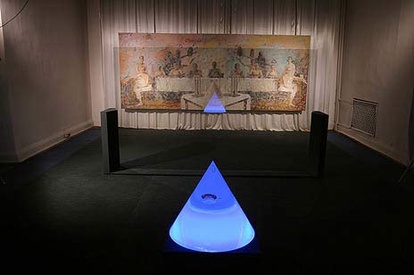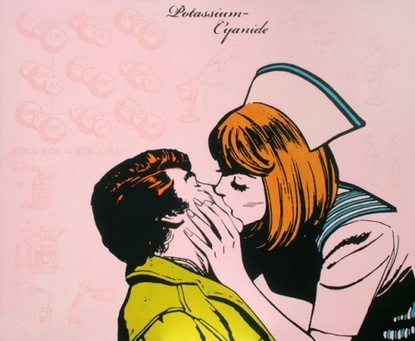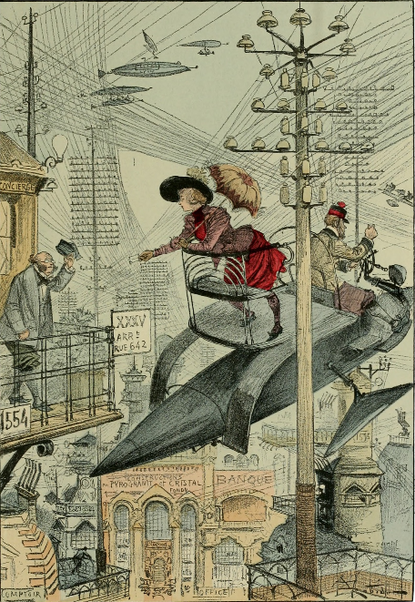‘Ladybirds’ and Universal Absurdity
Iryna Fedder is an artist of German origin, but has Ukrainian nationality. Her first presentation – in Ukraine – of the series ‘Tralfamadore; or The Love of Three Oranges’ was at the ART KYIV Contemporary 2013 Exhibition. In Germany, where Ms Fedder’s creativity has drawn a wide response, her paintings are called ‘New European Postmodernism’. ART UKRAINE decided to find out why the pictures by this Ukrainian artist impress Europeans; and how an existential novel by Kurt Vonnegut, ‘Slaughterhouse Five’ is combined with a fabulous play by Italian playwright Carlo Gozzi in the ‘Tralfamadore’ project.

Iryna Fedder
Olga Kostyrko: First I would like to ask: How have Kurt Vonnegut's novel ‘Slaughterhouse-Five’ and Carlo Gozzi’s ‘The Love of Three Oranges’ merged into one project ?
Iryna Fedder: It happened by chance. ‘Tralfamadore’ already existed as a fully-fledged, independent project; which had been shown at numerous exhibitions . In Germany it became well-known after an article in the newspaper ‘Die Welt’. I was given a palm tree, which I put into my white studio. The palm tree created a perceptible visual dissonance with the white background. I realized that this composition needed three oranges and then it dawned on me – this is Carlo Gozzi. I reached for the bookshelf, in the hope that this book – remembered since childhood – remained in my library.
Olga Kostyrko: The association was born earlier than you had realized?
Iryna Fedder: It happened spontaneously. In the process of reading and working , I had noticed a remarkable thing : many of the details of and facts about these [Vonnegut and Gozzi’s] two pieces of art are the same. Gradually, I began to feel the grain that unites them. Here is an example: there is a scene in ‘Slaughterhouse’ where Billy Pilgrim lies in the snow and sees Adam and Eve in the reflection of his polished boots. In ‘The Love of Three Oranges’ the Prince requires the same silver shoes, to go in search of the coveted fruit. The same silver shoes appear in ‘Slaughterhouse’ during the play ‘Cinderella’ which the British have introduced to the Germans. I was not looking for coincidences; they found me themselves.

Presentation of the Iryna Fedder's series "Tralfamadore; or The Love of Three Oranges" at the ART KYIV Contemporary 2013 Exhibition, Art Arsenal
Olga Kostyrko: Besides the parallels in the plots, what else unites these works?
Iryna Fedder: The bottom line was immediately clear to me: everyone is looking for an alternative way to survive. That alternative is based on hope. Some people do this unconsciously, by triggering fear – which blocks action and leads to madness; as with Vonnegut’s hero. By the way, Billy Pilgrim’s insanity is still a question for me: I re-read the novel many times, but cannot explain to myself whether he is really mad or just wants to see insanity in the eyes of others. The same thing with the Prince in Gozzi's fairy tale. He is obsessed with love for three oranges. He eagerly seizes this love because he needs it: this love becomes the purpose of his life. Everyone understands that passionate love for three oranges is impossible: this is a metaphor for a hope in which one finds raison d'être. I have seen a play by Carlo Gozzi in Germany, and I loved how the director felt and interpreted the idea: at the end of the play there are two giant books, one of which turns into a battle tank aimed at the audience. The director caught this idea: the internal war of a man within his little world. Prince, from the fairy tale, lived in his own restless little kingdom, where he should have been killed by foes for a power. This leads him to insanity, which eventually becomes his rescue. The play illustrates perfectly this absurdity, when he found oranges that turned into princesses. He does not understand what he wants and what he needs. He just laughs wildly, because he is happy he can to laugh as he did before. His insanity makes him normal.

Iryna Fedder , 'The Holly Bull'
Olga Kostyrko: Planet Tralfamadore – is it also a metaphor for hope?
Iryna Fedder: This is an alternative. In ‘Tralfamadore’ you can’t get a real sense of calmness; it's just an illusion. Tralfamadorians say that when a human pushes the button, war will start or everyone on the planet will die. But after awhile history repeats itself. When someone dies, the the planet’s inhabitants say ‘So it goes’. This is the only alternative for Tralfamadorians. Vonnegut said: ‘Leave my optimism, my utopia’. The only island of common sense for him was his hope and his faith. I have found my metaphor in this writer, in his Tralfamadore. Kurt Vonnegut is an iconic figure: he makes us go back to the very important things and he refers to other works. As a result, ideas are superimposed on one another; and a new idea is born. Kurt Vonnegut is more than a bible for me. He does not accuse and does not judge; what is more, you won't find any negative character in his novels.

Iryna Fedder, 'The Horses'
Olga Kostyrko: Do you remember when the first inhabitant from ‘Tralfamadore’ appears in your paintings?
Iryna Fedder: My first work ‘The Boy in the Costume of an Angel’ was painted earlier, even before I started reading Vonnegut. I drew a child who had been forgotten, at a fete. The boy painted his mouth with lipstick, to draw attention to himself. He sits there sadly, with a little toy boat in his hands; his looks convey disappointment. There are a lot of figurines of angels in Germany; they are really kitsch, staring at you from everywhere. I just wanted to create something sincere. I looked through a lot of baby pictures to capture this particular emotion. And when I started reading Vonnegut I was very surprised to find a terrible scene in which half the children were sold into slavery in Africa, and half died in a shipwreck. An incredible coincidence: my boy holds a toy boat in his hands. So, a metaphor appears. Children are vulnerable to pernicious influence. It is very easy to push a child in the wrong direction, no matter how wonderful the child is. Some day he picks up a toy gun, a seemingly harmless toy, and will go through his whole life with it. This has happened in Afghanistan – where children do not know life without war. Let’s recall the second title of the novel – ‘The Children's Crusade’. Young soldiers in the war are the same children, who were given the wrong toys .

Iryna Fedder, ‘The Boy in the Costume of an Angel’
Olga Kostyrko: In Germany, ‘Die Welt’ published an article in which your works were called ‘New European Postmodernism’. What do you think of this definition?
Iryna Fedder: After the article in ‘Die Welt’, a museum committee – of ten people – noticed me. This committee consisted of employees of the top Berlin art museums: Staatliche Museen, Berlinische Galerie. They came to my studio and for forty minutes were silent. It was a very curious scene, which ended with a question from Doctor Vagna. She asked whether I knew that my works were called ‘New European postmodernism’. I replied that I knew, but couldn’t understand what it meant. And it's true. My paintings are not something completely new, but they certainly have elements that draw attention to and separate my works from others. I suppose my works are ambiguous because of the combination of classical mural elements with my own black lines and spheres. I call them fassung - this very broad German word that can be translated into English as ‘setting’. My black lines and spheres hold the painting as a setting holds a gemstone. In the process of my work I have discovered an interesting thing – almost everything can be held in this setting. It seems these elements are in the painting itself and thus they should obstruct perception but, in contrast, they support the general idea. In fact, this is an inherently primitive design element that can refer to as a bar code. I put a painting, which in its tenderness is reminiscent of a fresco, in this setting. At first sight, these lines and black spheres give discord to the whole work; but this happens intentionally. I want interference, I want to provoke this conflict.

Iryna Fedder 'Vasya, go eat'
Olga Kostyrko: Your paintings were too sophisticated for public perception?
Iryna Fedder: Yes, but not to everyone. The categories are divided. My works are not beautiful in the canonical sense. Some people like my pictures aesthetically and after a while they try to understand the idea; some reject them peremptorily. There are no indifferent viewers. At the last exhibition one woman was absolutely shocked by my works, she even started to tell every viewer how terrible they were. I am very excited that someone can loathe them so much.

Iryna Fedder ' Cleopatra'
Olga Kostyrko: I know that your works were removed after the scandal at KULT School in Lichtenberg
Iryna Fedder: Yes, it's a very funny story. After the article in ‘Die Welt’ I was asked to do an exhibition specifically for the space in KULT school, which is in my neighborhood. I responded to the offer because I found it interesting to contribute to the cultural development of my area; and to do a little exhibition for people who may not have time to go to museums but who want to take part in art. I did a series of paintings with Van Gogh, squares and ladybirds; again, these have – for me – always been kind of kitschy in Germany. In fact, the ladybird is not as innocent as everybody thinks; it is a predator by nature. Those works resulted in a very strange reaction: it turned out that I had encroached on a myth. The next day it was reported that the Director was in shock, and ordered the works removed. This conflict happened for no reason at all. The ladybird has provoked such a scandal. Absurd, isn't it?

Olga Kostyrko










